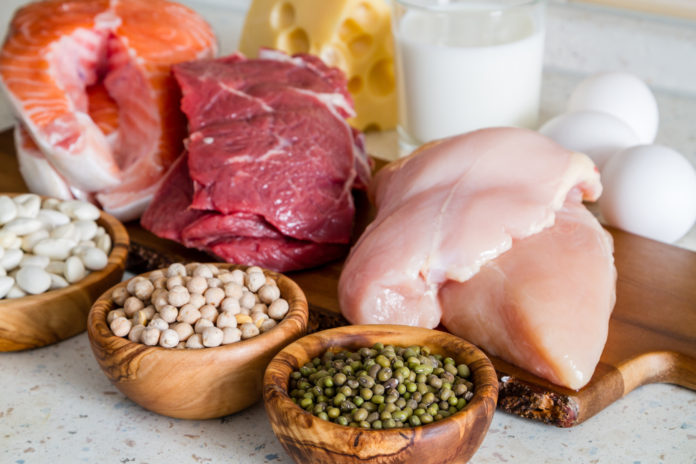
Coming out of a caloric deficit can be challenging for some. At this point, you’ve most likely dropped a significant amount of calories as well as increased cardiovascular work. Reverse dieting out is extremely important in my opinion as you’ll see time and time again that people will stop dieting, begin binging, and gain 20+ lbs of body fat back within a week. That pretty much ensures you’re going to be playing catch up the entire surplus/offseason and you will not have the most successful growing phase as you could. The goal would be to maintain a lean physique relative to the individual and slowly add back in calories to ensure fat gain is kept to a minimum. Obviously this amount to add back in over time varies drastically from person to person. Even more so, where those calories are coming from varies drastically from person to person. But one method I want to discuss today is beginning to add calories back in to someone’s diet, mainly from protein sources. Keep in mind this is merely one of hundreds of methods you can start a reverse diet. This is simply meant to educate and broaden your perspective on possible options and tools you can utilize during this period.
There are a number of reasons why increasing protein after a deficit may be more optimal for an individual than another way, so we’re going to go through some research to help you better understand why it holds merit. One study from Johnston et al in 2002 looked at postprandial thermogenesis in regards to a high protein/low fat diet compared with a high carbohydrate/low fat diet (1.) The recent literature suggests that high-protein, low-fat diets promote a greater degree of weight loss compared to high-carbohydrate, low-fat diets, but the mechanism of this enhanced weight loss is unclear. This study compared the acute, energy-cost of meal-induced thermogenesis on a high-protein, low-fat diet versus a high-carbohydrate, low-fat diet. The researchers had ten healthy, normal weight, non-smoking female volunteers aged 19-22 years were recruited from a campus population. Using a randomized, cross-over design, subjects consumed the high-protein and the high-carbohydrate diets for one day each, and testing was separated by a 28- or 56-day interval. Control diets were consumed for two days prior to each test day. On test day, the resting energy expenditure, the non-protein respiratory quotient and body temperature were measured following a 10-hour fast and at 2.5-hour post breakfast, lunch and dinner. Fasting blood samples were collected test day and the next morning, and complete 24-hour urine samples were collected the day of testing. The results showed postprandial thermogenesis at 2.5 hours post-meal averaged about twofold higher on the high protein diet versus the high carbohydrate diet, and differences were significant after the breakfast and the dinner meals (p < 0.05). Body temperature was slightly higher on the high protein diet (p = 0.08 after the dinner meal). Changes in the respiratory quotient post-meals did not differ by diet, and there was no difference in 24-hour glomerular filtration rates by diet. Nitrogen balance was significantly greater on the high-protein diet compared to the high-carbohydrate diet (7.6 +/- 0.9 and -0.4 +/- 0.5 gN/day, p < 0.05), and at 24-hour post-intervention, fasting plasma urea nitrogen concentrations were raised on the high protein diet versus the high-carbohydrate diet (13.9 +/- 0.9 and 11.2 +/- 1.0 mg/dL respectively, p < 0.05). These data indicate an added energy-cost associated with high-protein, low-fat diets and may help explain the efficacy of such diets for weight loss. We see that increasing dietary protein can increase the number of calories you burn for a given caloric intake. This means that coming out of a reverse diet, you can typically get away with adding in more calories to someone’s diet than if you were to begin adding in calories from other macronutrients (for a very simple example, say you can add 500 kcals from carbohydrates to someone’s reverse diet and they begin to reverse in a proper manner. If thats the case, you can typically get away with anywhere from 700 to possibly 900 kcals if you added those calories back in from protein. Again this is just an example and shouldnt be taken as hard specific numbers to stand by.)
References
- Postprandial thermogenesis is increased 100% on a high-protein, low-fat diet versus a high-carbohydrate, low-fat diet in healthy, young women. Carol S. Johnston, Carol S. Day, Pamela D. Swan. J Am Coll Nutr. 2002 (https://www.ncbi.nlm.nih.gov/pubmed/11838888)
- Effects of variation in protein and carbohydrate intake on body mass and composition during energy restriction: a meta-regression. James W. Krieger, Harry S. Sitren, Michael J. Daniels, Bobbi Langkamp-Henken. Am J Clin Nutr. 2006 (https://www.ncbi.nlm.nih.gov/pubmed/16469983)
- Protein, weight management, and satiety. Douglas Paddon-Jones, Eric Westman, Richard D. Mattes, Robert R. Wolfe, Arne Astrup, Margriet Westerterp-Plantenga. Am J Clin Nutr. 2008 (https://www.ncbi.nlm.nih.gov/pubmed/18469287)
- Indicator Amino Acid-Derived Estimate of Dietary Protein Requirement for Male Bodybuilders on a Nontraining Day Is Several-Fold Greater than the Current Recommended Dietary Allowance. Bandegan A, Courtney-Martin G, Rafii M, Pencharz PB, Lemon PW. J Nutr. 2017. (https://www.ncbi.nlm.nih.gov/pubmed/28179492)
- Effect of a high-protein breakfast on the postprandial ghrelin response. Wendy A. M. Blom, Anne Lluch, Annette Stafleu, Sophie Vinoy, Jens J. Holst, Gertjan Schaafsma, Henk F. J. Hendriks. Am J Clin Nutr. 2006 (https://www.ncbi.nlm.nih.gov/pubmed/16469977)
- Ghrelin and glucagon-like peptide 1 concentrations, 24-h satiety, and energy and substrate metabolism during a high-protein diet and measured in a respiration chamber. Manuela P. G. M. Lejeune, Klaas R. Westerterp, Tanja C. M. Adam, Natalie D. Luscombe-Marsh, Margriet S. Westerterp-Plantenga. Am J Clin Nutr. 2006 (https://www.ncbi.nlm.nih.gov/pubmed/16400055)
- Higher protein intake preserves lean mass and satiety with weight loss in pre-obese and obese women. Heather J. Leidy, Nadine S. Carnell, Richard D. Mattes, Wayne W. Campbell. Obesity (Silver Spring) 2007 (https://www.ncbi.nlm.nih.gov/pubmed/17299116)
- The satiating effect of dietary protein is unrelated to postprandial ghrelin secretion. Lisa J. Moran, Natalie D. Luscombe-Marsh, Manny Noakes, Gary A. Wittert, Jennifer B. Keogh, Peter M. Clifton. J Clin Endocrinol Metab. 2005 (https://www.ncbi.nlm.nih.gov/pubmed/16014402)
- Effects of Meals High in Carbohydrate, Protein, and Fat on Ghrelin and Peptide YY Secretion in Prepubertal Children. Lomenick, J. P., Melguizo, M. S., Mitchell, S. L., Summar, M. L., & Anderson, J. W. (2009). The Journal of Clinical Endocrinology and Metabolism. (https://www.ncbi.nlm.nih.gov/pmc/articles/PMC2775646/)
- Ghrelin enhances appetite and increases food intake in humans. A. M. Wren, L. J. Seal, M. A. Cohen, A. E. Brynes, G. S. Frost, K. G. Murphy, W. S. Dhillo, M. A. Ghatei, S. R. Bloom. J Clin Endocrinol Metab. 2001 (https://www.ncbi.nlm.nih.gov/pubmed/11739476)


















